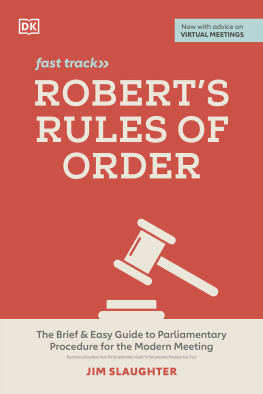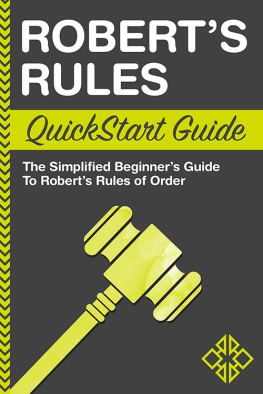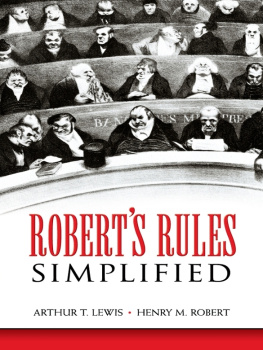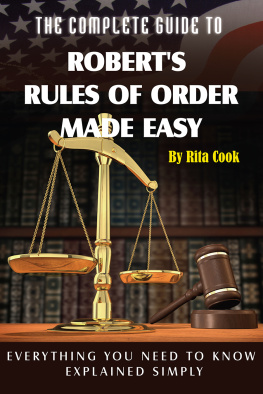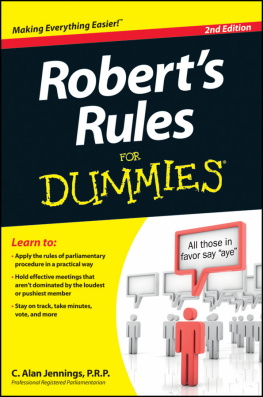ROBERTS RULES
OF ORDER
NEWLY REVISED
In Brief
ROBERTS RULES
OF ORDER
NEWLY REVISED
In Brief
UPDATED TO ACCORD WITH
THE ELEVENTH EDITION
OF THE COMPLETE MANUAL

HENRY M. ROBERT III
WILLIAM J. EVANS
DANIEL H. HONEMANN
THOMAS J. BALCH
with the assistance of
DANIEL E. SEABOLD
SHMUEL GERBER

Da Capo Press
A Member of the Perseus Books Group
Copyright 2004, 2011 by Henry M. Robert III, Trustee for the Roberts Rules Association
All rights reserved. No part of this publication may be reproduced, stored in a retrieval system, or transmitted, in any form or by any means, electronic, mechanical, photocopying, recording, or otherwise, without the prior written permission of the authors. All permission requests should be sent directly to: John Robert Redgrave, Authors Agent, Roberts Rules Association, 7377 Brodie Court, Sarasota, Florida 34238-8500. Printed in the United States of America.
Text design by Lisa Kreinbrink
Set in 10-point Goudy by Eclipse Publishing Services
Roberts rules of order newly revised in brief2nd ed.
ISBN 978-0-306-82019-9
Cataloging-in-Publication Data is available from the Library of Congress
Library of Congress Control Number: 2011932261
For questions and answers and further information on parliamentary
procedure visit www.robertsrules.com
Published by Da Capo Press
A Member of the Perseus Books Group
www.dacapopress.com
Da Capo Press books are available at special discounts for bulk purchases in the U.S. by corporations, institutions, and other organizations. For more information, please contact the Special Markets Department at the Perseus Books Group, 2300 Chestnut Street, Suite 200, Philadelphia, PA 19103, or call (800) 810-4145, ext. 5000, or e-mail .
1 2 3 4 5 6 7 8 9 10 16 15 14 13 12 11
_____________________
In a land where perhaps most persons...
are members of one or more societies,
some knowledge of parliamentary [procedure]
may be justly regarded as a necessary part
of the education of every man and woman....
HENRY M. ROBERT
_____________________
CONTENTS
ROBERTS RULES
OF ORDER
NEWLY REVISED
In Brief
How many times have you been to a meeting that didnt go well? Did it seem that the chair didnt keep order? Was there a feeling that something was railroaded? Did it take an interminable amount of time to settle the simplest things? What was wrong?
When people want to do something as a group, they must first agree on exactly what it is they want to do and how they want to go about it. In other words, they must work together to make some decisions. Sometimes it may take some zeroing in even to get at the what? At other times that may be generally understood and the necessary decisions may involve mostly the how to?
If there are only three or four persons in the group, you are right if you wonder why they should need a book like this. Common sense tells us that all they need to do is sit down in one room as people bent on working out where they want to go in a courteous spirit without wasting anyones time. They should all try to agree; but if they cant and a majority want to go ahead with something, the group may want to have an understanding that the majoritys will should prevail. Whoever is taking the lead may want to note down what has been decided and provide each person with a copy.
But make it even a half dozen people who are meeting in this way, and you will soon see the need for at least some formal control. Too many people may try to talk at once. Some may not be able to get a word in edgewise. People may wander off the subjector may even lose sight of what the proper subject is. And if things arent handled right, they may come out of the meeting with different understandings of what was or was not agreed to.
To prevent this, you will need to pick one person to chair the meetingto designate who may speak at any given time and to see that the discussion narrows down to specific, precisely worded proposals. These should be recorded, and should be voted on unless there is obvious total agreement.
When the gathering reaches a size of about 12 to 15 persons, another threshold is crossed. At that point, the meeting becomes essentially full scale, with a need for tighter, more formal, more carefully developed control. A certain paradox appears. In order to preserve its freedom to act, the body must impose regulation.
The needed control must not only keep order. It must of course be geared to getting the business done and resolving any issues that may arise along the way. Buteven more importantit must do these things in a way thats fair to everyone taking part in the process. And in this theres more than may meet the eye.
Control of this kind naturally must be imposed by the person who conducts the meetinggenerally called the chairman. There are a multitude of details that must be determined through him or her. Who gets to speak when? How is the meeting to be kept on track? What if discussion tends to go on forever? How is intense disagreement to be handled? How can business best be put through when there is no disagreement? What if a proposal appears to be not yet in shape for a yes-or-no decision? And in a group like a club that has a continuing existence, how is business to be carried over from one meeting to the next if that seems desirable? All these things and many more are potential stumbling blocks when a large number of people are involved.
Whoever is chairman will soon come up against a significant fact of life related to gatherings of this kind. In them, it is virtually impossible for any human being to perform the function of chairman fairly under all the situations that may arise, without a considerable body of established rules to go by. No one can do it just out of his or her own head.
Parliamentary procedure is the name given to the tradition of rules and customs that has grown up in the civilized world for dealing with these problems. A bit of it goes back as far as the ancient Greeks. But its basic content was mainly formed by centuries of trial and error in the English Parliament, from which the name parliamentary procedure comes.
Not everyone may realize that the organizations most of us get involved in at some time or other are essentially similar to great legislative assemblies in an important way. They all meet to decide on actions to be taken. For this reason, they are all known as deliberative assemblies.
Major law-making bodies usually develop their own particular rules. This is largely impractical, however, in ordinary organizations as far as rules of meeting procedure are concerned. Each group of this kind obviously must work out its own structure. But things work best if most of the rules for making decisions in meetings are the same from group to group. Obviously, it would be worse than burdensome if one had to use different rules for deciding matters every time he or she took part in a different organization. By general understanding in our culture, parliamentary procedure fills the role of supplying this needed common body of rules.
Although originally derived from practices in the English Parliament, parliamentary procedure as it exists in America today has gradually evolved somewhat differently. Henry Martyn Robert (18371923), a distinguished engineer who retired from the U.S. Army as a brigadier general, had considerable influence on this development. A self-taught, in-depth student of the subject who was active in many organizations, he first published his



